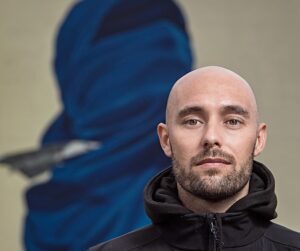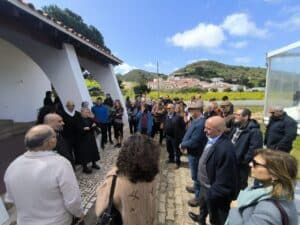Taking up an ideal vantage point, Irish photographer Garrett Walsh pictures one of Portugal’s most ancient fortified towns. For centuries a strategic look-out point across the Alentejo plains, the image encompasses much of the history of Monsaraz. Always seeking out memorable images, the owners of ‘Côrte-Real’ have displayed Garrett’s beautiful composition at their gallery in Paderne.
“It exemplifies the importance of many similar fortifications along the River Guadiana,” says Pedro Côrte-Real, co-owner of the gallery. Notably in the Algarve at Castro Marim, close to the river’s mouth, there is a Knights Templar Castle and the Fort of São Sebastião. Further up stream at Alcoutim there are two castles, one of them in ruins and the other, fully restored, is open to the public.
Menacingly, on the opposite bank of the Guadiana, there is an impressive Spanish castle, a reminder of centuries of conflict between Portugal and Spain.
Traveling into the Alentejo, there is the walled citadel of Mértola and, further north, the 13th century fortress town of Monsaraz. Retaining its medieval character, the little town is entirely unspoiled and vehicle free.
“Time has merely aged it, not changed it,” says the photographer. Born and brought up in Ireland, Garrett Walsh is now an established professional photographer working in the Algarve. “There is no shortage of castles in Ireland,” he says citing Dunamase, Cahir and the Rock of Cashel.
“In Portugal, Monsaraz is particularly inspiring. Far from being a ruin or a tourist attraction, life continues in the town as it must have done for hundreds of years.”
Describing it as a fairytale location, “there are 150 inhabitants living in pristine whitewashed houses,” he explains.
Garrett spent time photographing the ornate parish church with its gilded altar, the globe-topped pillary in the town’s main square and the castle’s granite battlements.
Of all these images it is his eagle-eyed view across the surrounding countryside that is so compelling. Once carpeted with wild Rock Roses, the area was named Monte Xarez after these indigenous shrubs.
During the 16th century, the Duke of Braganza divided his land into a number of small manageable plots. Trying to attract farmers to work on his estate, the way the land was divided can still be seen today. “The town has hardly altered and the countryside remains unchanged,” says Garrett.
His image of this age-old landscape – reproduced using the Giclée process as a Fine Art print – is testimony to the fact that Monsaraz has not been touched by the passage of time.
Visit Côrte- Real’s new Pop-Up Gallery located above the estate agents ‘Fine and Country,’ close to the beach in the centre of Carvoeiro, Rua do Barranco.
The main gallery ‘Galeria Côrte-Real’ is signposted from Boliqueime, Ferreiras and Paderne. Open Thursday to Sunday, from 11am until 5pm
912 737 762 | www.corterealarte.com
By Carolyn Kain
Photo: Monsaraz photographed by Garrett Walsh























